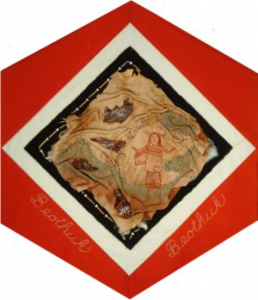Beothuk

The Block
Black felt is used to show that this block has been created in memoriam of the Beothuk. The block is the design work of Studio Inspirations and was stitched by Cynthia Jackson. Beads, cedar bark, and rabbit fur, on caribou hide are used to create a map of the archaeological site at Boyd’s Cove. The “Dancing Woman” is from a drawing done by Nancy Shanawdithit, the last known living Beothuk. The image was re-created using red paint, a colour that symbolized life and health in Beothuk culture.
Cultural Profile
The Beothuk, once the Aboriginal inhabitants of Newfoundland, are now extinct. They were hunters and fishers who depended upon coastal resources during the summer and moved inland in fall to hunt caribou and smaller fur bearers. The Beothuk were likely the first North American natives to encounter European explorers. Their practice of covering their bodies and belongings with red ochre became a marker of tribal identity and caused Europeans to call them “Red Indians.”
In 1497, when John Cabot discovered Newfoundland, the Beothuk numbered about 500. By the winter of 1822-23 disease and starvation had so ravaged their communities only 27 were left. Over time, the encroachment on Beothuk territory by European settlers and Mi’gmaq from Cape Breton Island severely diminished their access to vital resources. This led to a vicious cycle of retaliatory conflicts. Armed only with bows and arrows, the Beothuk suffered heavy losses. Belated reconciliation attempts by Newfoundland governors were unsuccessful.
The last known Beothuk, Nancy Shanawdithit, was captured in April 1823 and later placed under the care of William Eppes Cormack (founder of the Beothuk Institution) in St John’s. Aided by sketches and broken English she communicated to him much of what is now known about Beothuk history and culture. Shanawdithit died of tuberculosis in June 1829 and was buried in St John’s.
Sponsor: Joyce and Jack McGaughey
